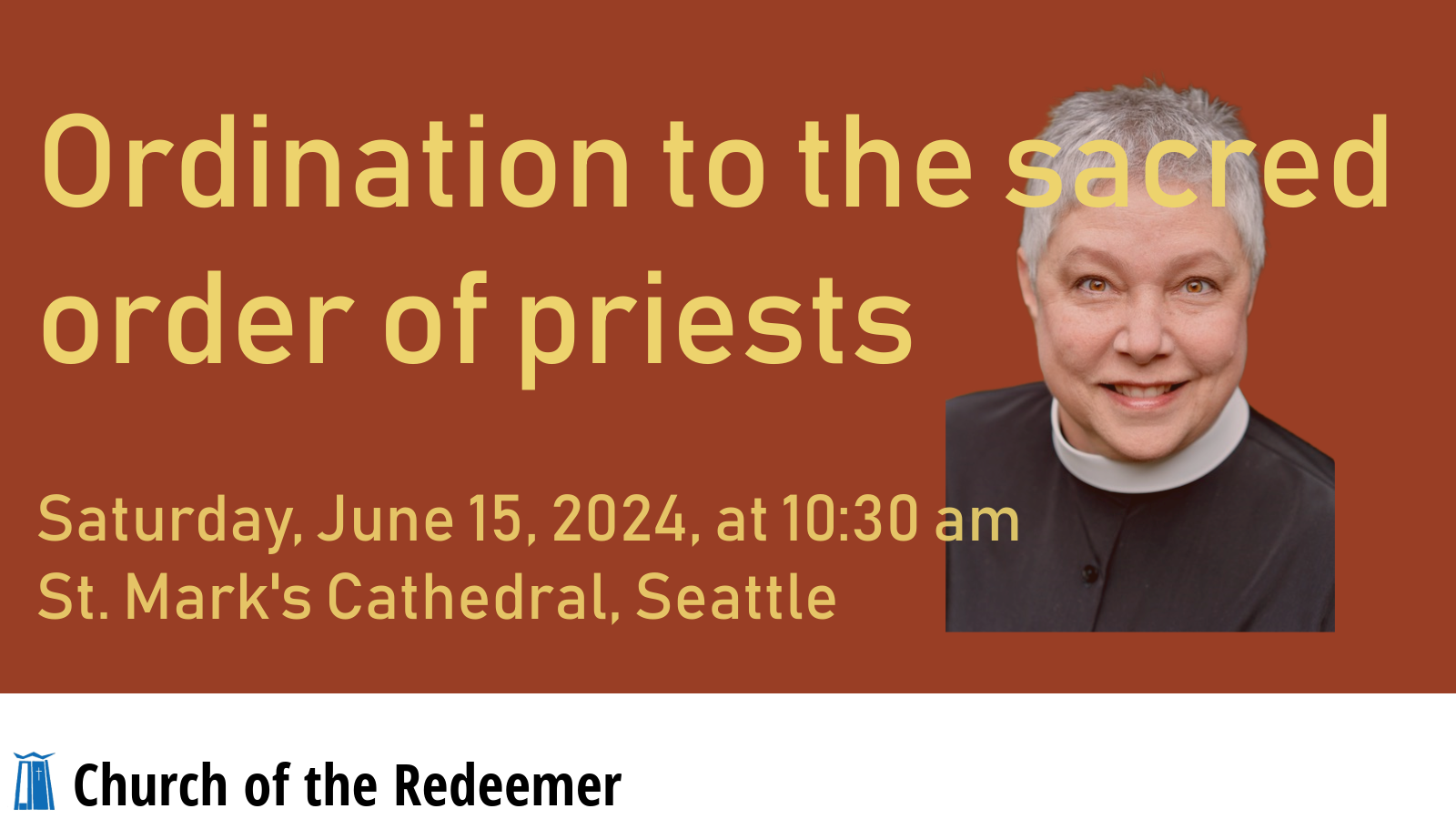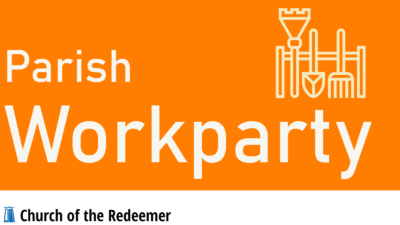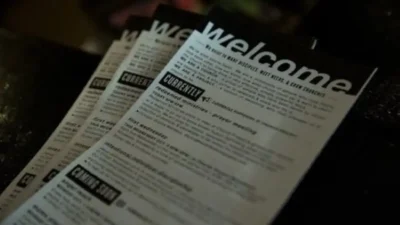God willing and the people consenting, the ordination of the Rev. Theresa Newell, our deacon, to the sacred order of priests happens on Saturday, June 15, 2024, at 10:30 am at St. Mark’s Cathedral, 1245 10th Ave. East in Seattle.
All are invited to attend. Archbishop Skelton will ordain six people that morning, so parking is likely to be tight. We recommend carpooling or public transit.
For those unable to attend, your prayers are requested. You may watch the service live-streamed on the St. Mark’s website.

Ordination
Ordination is a sacramental rite of the church by which God gives authority and the grace of the Holy Spirit through prayer and the laying on of hands by bishops to those being made bishops, priests, and deacons (Book of Common Prayer, pp. 860-861). The three distinct orders of bishops, priests, and deacons have been characteristic of Christ’s holy catholic church.
- Bishops carry on the apostolic work of leading, supervising, and uniting the church.
- Presbyters (often known as priests) are associated with bishops in the ministry of church governance, along with the church’s ministry of missionary and pastoral work, in preaching of the Word of God, and in the administration of the sacraments.
- Deacons assist bishops and priests in all of this work, and have special responsibility to minister in Christ’s name to the poor, the sick, the suffering, and the helpless (Book of Common Prayer, p. 510).
Ordination rites
The Book of Common Prayer provides rites for the ordination of bishops (p. 512), priests (p. 525), and deacons (p. 537).
The earliest known text of ordination rites is in the Apostolic Tradition of Hippolytus (c. 215).
The 1549 BCP did not include ordination rites. The Church of England published “The Form and Manner of Making and Consecrating of Archbishops, Bishops, Priests, and Deacons” in 1550. Many subsequent revisions of the Prayer Book included rites for ordination.
The Preface to the Ordination Rites of the Prayer Book notes that the church intends to maintain and continue the three orders of bishops, priests, and deacons. Therefore, the church appoints ordination services . Unless ordained, no person is to exercise the office of bishop, priest, or deacon. The manner of ordination in the Episcopal Church has been generally recognized by Christian people as suitable for conferring the sacred orders of bishop, priest, and deacon.
Ordination services
The services of ordination include the following:
- A presentation of the ordinand to the ordaining bishop or bishops.
- The ordinand’s Declaration of Consent that states their belief in the scriptures and conformity to the doctrine, discipline, and worship of the Episcopal Church.
- The people’s consent to the ordination and their promise to uphold the ordinand in the new ministry.
- The Litany for Ordinations (BCP, pp. 548-551).
- Lessons and sermon.
- The examination of the candidate or candidates.
- The singing of the hymn “Veni Creator Spiritus” or “Veni Sancte Spiritus.”
- A period of silent prayer.
- The prayer of consecration and laying on of hands by the ordaining bishop or bishops.
- Vesting of the newly ordained person according to their new order of ministry.
- Participation in the eucharist by the newly ordained person in ways that are appropriate to their order of ministry.
At the ordination of a bishop, the Presiding Bishop (or designee) and at least two other bishops lay their hands on the ordinand’s head. At the ordination of a priest, priests join the bishop in the laying on of hands. Only the bishop lays hands on the head of the ordinand at the ordination of a deacon.
The bishop-elect leads the Nicene Creed at the ordination of a bishop after the Examination. The Creed precedes the Examination at the ordination of a priest or a deacon.
The newly ordained bishop is the chief celebrant at the eucharist. A newly ordained priest joins in the celebration of the eucharist with the bishop and other presbyters. A newly ordained deacon may prepare the Lord’s table and dismiss the people at the eucharist.
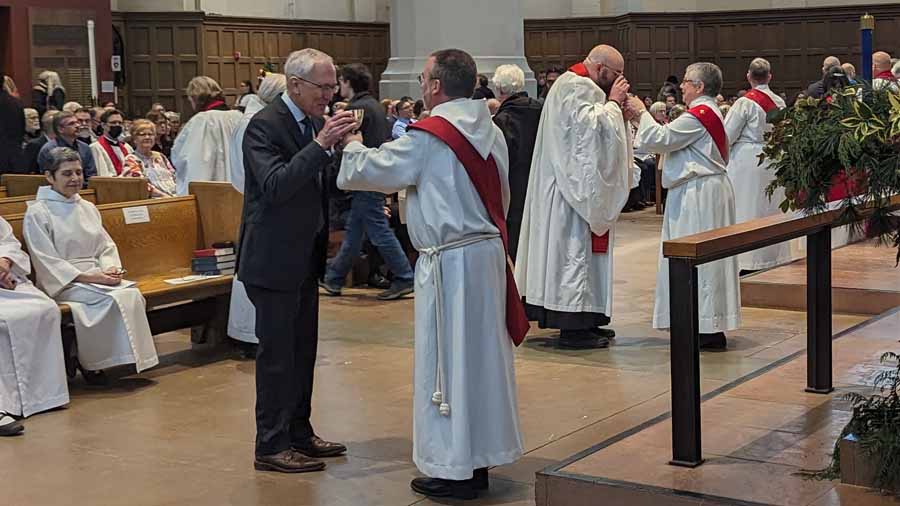
A life-long vocation
Normally, the Episcopal Church sees ordained ministry as a life-long vocation. The canons require careful selection, discernment, and preparation before ordination takes place, calling for the following:
- Theological instruction in the Holy Scriptures; church history, including the ecumenical movement.
- Christian theology.
- Christian ethics and moral theology.
- Studies in contemporary society, including racial and minority groups.
- Liturgics and church music.
- Theory and practice of ministry.
The diocese and bishop may modify the requirements and standards of learning may in the ordination of local priests and deacons.
The Book of Occasional Services provides a form for the “Reaffirmation of Ordination Vows.”
[This information comes from Ordination.]
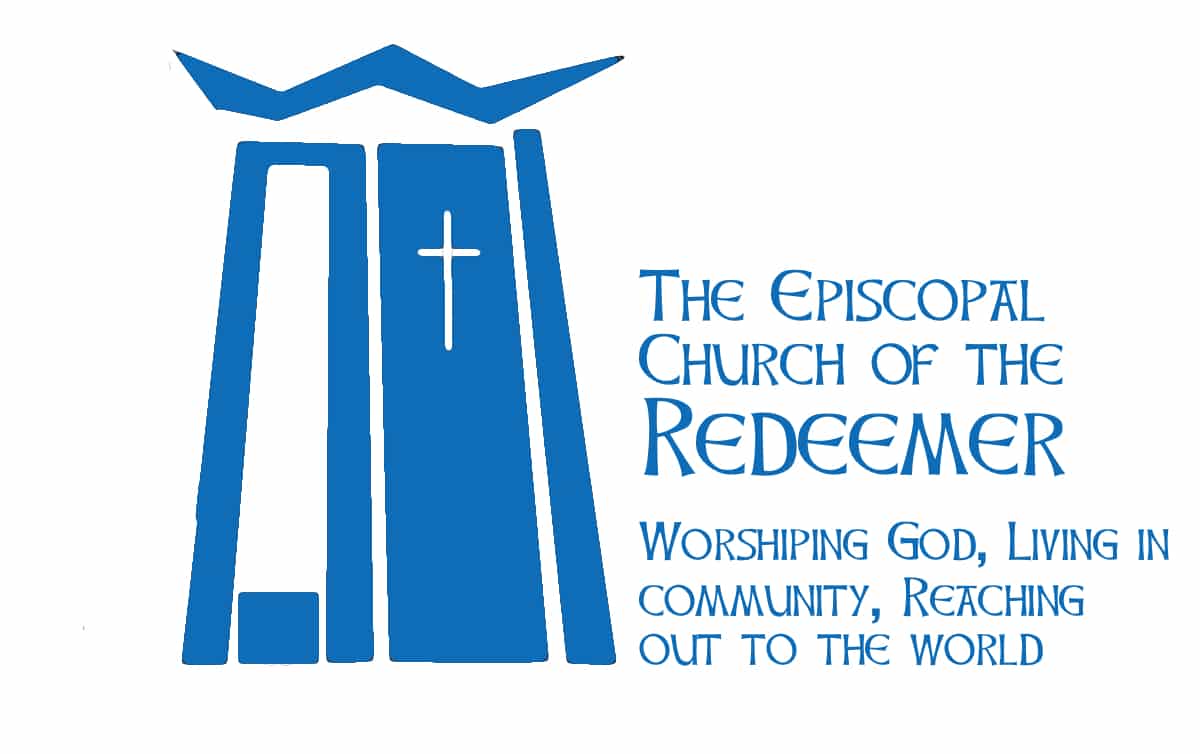
Church of the Redeemer
Church of the Redeemer: Worshiping God, living in community, and reaching out to the world around us. We are an Episcopal Church serving north King County and south Snohomish County, Washington. As you travel your road, go with friends walking the way of Jesus at Redeemer.
Church of the Redeemer is at 6210 Northeast 181st Street in Kenmore, Washington. The campus is a short distance north of Bothell Way, near the Burke-Gilman Trail. The entrance looks like a gravel driveway. The campus is larger on the inside than it is on the outside. And we managed to hide a large building on the side of a hill that is not easily seen from the street.
The Episcopal Church welcomes you.

